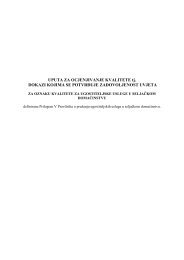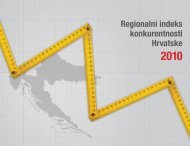SOCIO-ECONOMIC CONTEXT CHAPTER 2Table 1: Dominant work relationships in <strong>Croatia</strong> (2002-2004)2002.u %2004.u %DifferenceWages and full insuranceTotalPublic sector employeesPrivate sector employeesSelf-employed and helping family membersShort term contracts and own account workers77.090.788.140.15.085.499.696.946.18.9+8.4+8.9+8.8+6.0+3.9Types of contractsOpen-<strong>end</strong>ed contactsFixed-term contractsSeasonal contractsShort-term contracts87.59.71.31.587.610.31.30.8+0.1+0.60-0.7Duration of contractLess than 1 month1-5 months6-12 months12 months and longerAs required3.151.615.78.920.72.154.917.79.515.9-1.0+3.3+2.0+0.6-4.8Duration of employment with present employerUnder 1 year1 to 10 years11 to 20 yearsMore than 20 years12.147.420.321.78.751.514.924.9-3.4+4.1-5.4+3.2Source: Labour force survey, 2002 and 2004.The security of full remuneration and work-related insuranceis enjoyed almost equally amongst public and privatesector employees, as indicated by the change from 2002 to2004. In general, all members of the employed class havemanaged to improve their status in this regard except forthe self-employed, domestic care givers, and contractors.These groups have coverage below 50% and below 10%,respectively. There have also been some minor changesto the popular terms of contract employment. There hasbeen a slight increase in the amount of both open-<strong>end</strong>edand fixed-term contracts. Correspondingly, there has beena reduction in the amount of short-term contracts, whichoffer the least amount of job security.Despite these positive developments, there hasalso been an increase in fixed-term contracts with aterm of only 1 to 5 months. In 2002, there were only51.6% of such contracts, which rose to over 54% in2004. However, the number of new employmentopportunities that offer a fixed-term contract is increasingand is now over 85%. In terms of duration ofemployment, there has been an increase from 47.4%to 51.5% among those who have been with theirpresent employer for 1-10 years. In fact all bracketsof employment duration have increased with theexception of those who have been with their presentemployer for 11-20 years.29
CHAPTER 2SOCIO-ECONOMIC CONTEXTFlexicurity – can an agreement be reached?According to economic indicators, it would appearthat the degree of flexibility in the <strong>Croatia</strong>n labourmarket has not increased. In fact, it seems that theglobal tr<strong>end</strong> towards more flexibility and less securityis not occuring in <strong>Croatia</strong>. In the past two years therehave been no changes in the legislative framework relatingto the labour market, but there are expectationsfrom trade unions that certain changes in Labour Lawand Employment Law will be made. The major pointsof contention have not been made public yet butthere will be attempts to bring more security into thelegislature, as a reaction to the growing market shareof contract work. High levels of unemployment andslow job creation are put forward as arguments demonstratingthat increasing flexibility has only reducedsecurity for the existing work force to the benefit ofoutsiders (i.e. those who are exposed to the churningof the labour market, mostly young and first-time jobseekers). While it is true that an increase in flexibility isnot in itself enough to generate new employment, if<strong>Croatia</strong> were to continue with higher levels of protectionrelative to the region, maintaining competitivenesswould become difficult. The economic edge in<strong>Croatia</strong> would need to stem from high quality goodsand services which sustain higher wages and whichrequire highly skilled human resources.Like Denmark and the Netherlands, <strong>Croatia</strong> is a small,export-based, liberal economy. As such it will haveto learn to combat the insecurity which comes fromincreasing liberalisation, with the understanding thata high level social security system such as Denmark’sis very costly, and as such not an option for <strong>Croatia</strong>.However, the trust between social partners in <strong>Croatia</strong>is still not strong enough to support such a difficultbut open dialogue.2.5 Regional DisparitiesRegional economic disparities are greatly determinedby the presence of industry, level of income, developmentof small businesses, damage caused by war, andspatial mobility of the labour force. At the moment,strong labour demands are only present in a few regionsin <strong>Croatia</strong> – the City of Zagreb, and the Counties of Istriaand Primorje-Gorski Kotar. In all other <strong>Croatia</strong>n counties,the number of registered unemployed far exceedsthe number of job vacancies. Traditionally, economicdifficulties are most evident in rural areas, however theislands are also suffering from comparative disadvantagessimilar to areas affected by war.Existing regional differences have been intensified by apronounced difference in the amount of foreign tourismeach area receives, which affects seasonal employment.Approximately two-thirds of tourists stay in Istria,the County of Primorje-Gorski Kotar, and the County ofSplit-Dalmatia, while the continental parts of <strong>Croatia</strong>,especially Lika, Kordun and Eastern Slavonia, do notshow the same benefits from this market.<strong>Croatia</strong> has yet to make a definitive decision regardingits regional organisation. Currently the only datasetsavailable are related to unemployment levels and GrossDomestic Product (GDP) per county. In 2005, the highestnumber of unemployed people was in the City of Zagreband in the County of Split-Dalmatia. However, thehighest unemployment rates (unemployed populationrelative to the general population) were in the Countyof Vukovar-Srijem, the County of Sisak-Moslavina, andthe County of Brod-Posavina. According to the latestavailable data from 2002, GDP per capita in the mostdeveloped county, the City of Zagreb, was 71,111 HRKor 9,597 EUR. This is just over three times higher than inthe GDP per capita in the least developed county, theCounty of Vukovar-Srijem (23,400 HRK or 3,158 EUR).30

















